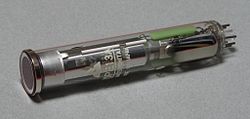Doug Kerr
Well-known member
Many newcomers to digital photography are baffled to see the sensor of a newly-announced camera described as being of size "1/1.7 inch".
This repugnant convention has an interesting history.
An important breakthrough in the matter of economical video cameras came with the introduction of the Vidicon image tube in the 1950s. An important early class had a "target" (today we would say "sensor") of nominal dimensions 8.8 mm × 6.6 mm. They were commonly used in "industrial" video cameras.

"2/3 inch" Vidicon Tube
Matsushita 20PE13A
An alternative type had a target about 50% larger in its linear dimensions, and was used where better image quality was needed (perhaps commercial "studio" cameras).
The technicians involved with this equipment weren't generally conscious of the exact size of the target. They were familiar with distinguishing the different sizes of cathode ray tubes (CRTs) used for video display in terms of their nominal "bottle diameter". (A "7 inch" CRT did not accommodate a rectangular display screen with a diagonal measurement of 7 inches; rather it was in a "bottle" whose diameter was close to 7 inches.)
So in the familiar way, the technicians came to identify these two popular classes of Vidicon tube classes as the "2/3 inch" and "one inch" types, in terms of their nominal "bottle diameters".
When the earliest digital cameras for general use emerged, marketeers were worried that consumers might by horrified by their terribly tiny sensor sizes (perhaps as small as 4 mm × 3 mm - a diagonal dimension of 0.2 inch). Thus the clever idea was adopted of using the "Vidicon bottle" convention. With that, a 4 mm × 3 mm sensor could be described as the "0.3 inch" size. But that still sounded terribly tiny.
So the step was taken of expressing "0.3 inch" as "1/3.3 inch" (perfectly proper mathematically). And "3.3" (especially close to the word "inch") sounded rather comforting - not tiny at all. So this led to the convention we widely see today.
In any case, if a sensor is described, under this convention, as "1/n inch size", its diagonal dimension is 16.5/n mm. Thus, a "1/2.8 inch" sensor. found in many smaller compact cameras today, will have a sensor whose approximate diagonal dimension is 5.9 mm (about 0.23 inch).
I call a sensor that size a "5.9 mm sensor."
For reasons of nostalgia, the "2/3 inch" size (not often encountered in digital still cameras) is exempt from the second stage of that foolishness, and is still called "2/3 inch" (rather than "1/1.5 inch"). And the "four thirds" size is about twice that big (it could be called "1/0.75 inch").
Best regards,
Doug
This repugnant convention has an interesting history.
An important breakthrough in the matter of economical video cameras came with the introduction of the Vidicon image tube in the 1950s. An important early class had a "target" (today we would say "sensor") of nominal dimensions 8.8 mm × 6.6 mm. They were commonly used in "industrial" video cameras.
"2/3 inch" Vidicon Tube
Matsushita 20PE13A
An alternative type had a target about 50% larger in its linear dimensions, and was used where better image quality was needed (perhaps commercial "studio" cameras).
The technicians involved with this equipment weren't generally conscious of the exact size of the target. They were familiar with distinguishing the different sizes of cathode ray tubes (CRTs) used for video display in terms of their nominal "bottle diameter". (A "7 inch" CRT did not accommodate a rectangular display screen with a diagonal measurement of 7 inches; rather it was in a "bottle" whose diameter was close to 7 inches.)
So in the familiar way, the technicians came to identify these two popular classes of Vidicon tube classes as the "2/3 inch" and "one inch" types, in terms of their nominal "bottle diameters".
When the earliest digital cameras for general use emerged, marketeers were worried that consumers might by horrified by their terribly tiny sensor sizes (perhaps as small as 4 mm × 3 mm - a diagonal dimension of 0.2 inch). Thus the clever idea was adopted of using the "Vidicon bottle" convention. With that, a 4 mm × 3 mm sensor could be described as the "0.3 inch" size. But that still sounded terribly tiny.
So the step was taken of expressing "0.3 inch" as "1/3.3 inch" (perfectly proper mathematically). And "3.3" (especially close to the word "inch") sounded rather comforting - not tiny at all. So this led to the convention we widely see today.
In any case, if a sensor is described, under this convention, as "1/n inch size", its diagonal dimension is 16.5/n mm. Thus, a "1/2.8 inch" sensor. found in many smaller compact cameras today, will have a sensor whose approximate diagonal dimension is 5.9 mm (about 0.23 inch).
I call a sensor that size a "5.9 mm sensor."
For reasons of nostalgia, the "2/3 inch" size (not often encountered in digital still cameras) is exempt from the second stage of that foolishness, and is still called "2/3 inch" (rather than "1/1.5 inch"). And the "four thirds" size is about twice that big (it could be called "1/0.75 inch").
Best regards,
Doug
